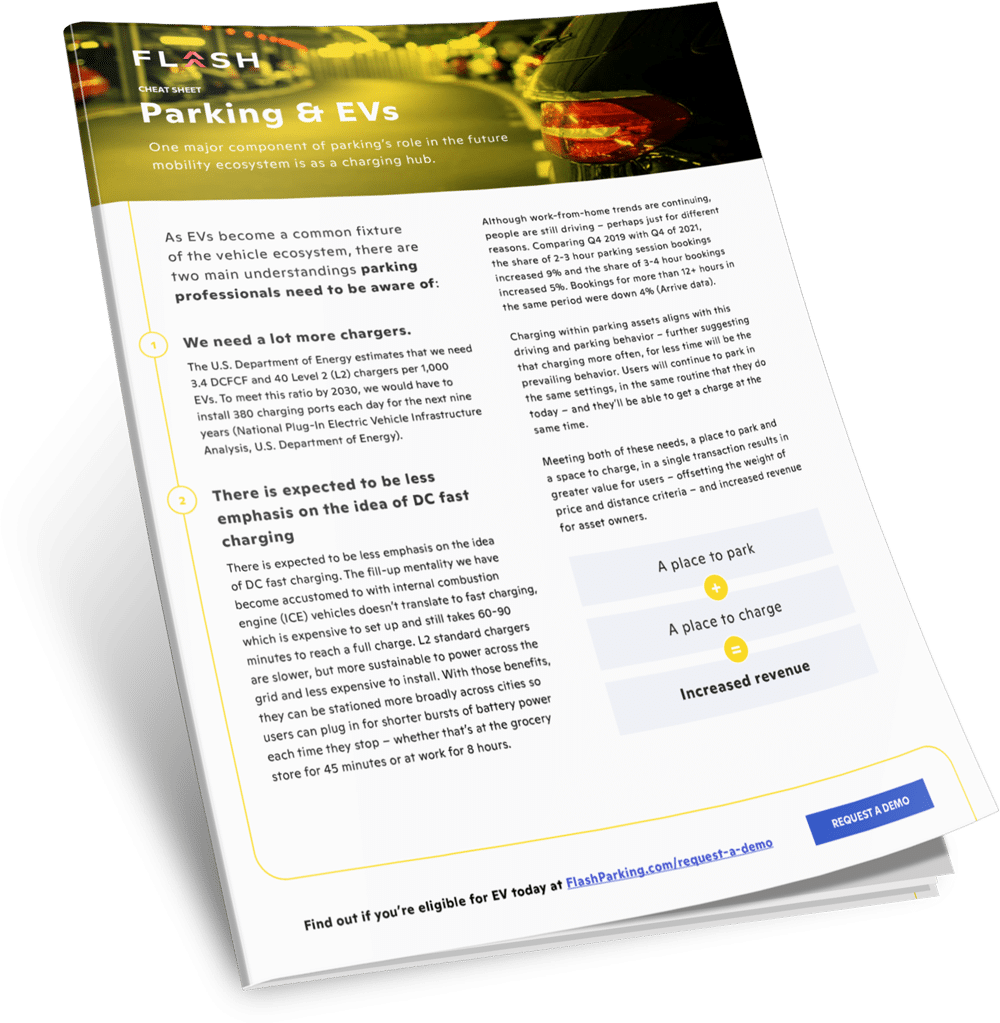“Revolution” is a strong word.
But, the growing mass adoption of electric vehicles is nothing short of a revolution toward sustainable mobility and for the parking industry at large. EV parking opens new sources of reliable and sustainable revenue for operators. It also introduces completely new realms of utility for the average parking asset. It’s no longer just a place to stash your vehicle—it opens the notion that operators can do more for your car. Once the customer is open to recharging in an asset, there are pathways for other types of servicing opportunities.
The parking industry is essential in the path to an electrified future. Read on for a breakdown of what’s behind the EV revolution and how operators can prepare and benefit.
Who Is Powering the EV Revolution?

The forward inertia of EV in mobility is due to three broad factors: government intervention, attitudes toward sustainability, and technological efficiency. Each bucket impacts how deeply and quickly electric vehicles will penetrate the market.
Government intervention is a primary catalyst for auto manufacturers to take action. The Infrastructure Investment and Jobs Act signed into law is a start toward the plan for 500,000 EV chargers nationwide. Now, the government is exploring tax credits and incentives for consumers and businesses to adopt EVs. Whichever incentives and deals congress lands on, the ball has started rolling and will lead to greater public adoption.
Attitudes toward sustainability and public sentiment have led to increases in EV adoption. The EPA has identified transportation as the largest contributor to greenhouse gas emissions in recent years, with cars, trucks, and public transportation making up the largest segment. While Europe and China lead the global EV market, the US is likely to gain traction as an effort to combat climate change and reduce reliance on fossil fuels.
Technological efficiency grows every year and allows smarter solutions for everyday problems. EVs will rely on the latest charging tech to function. That’s why companies like EVBox, which powers our own EV solutions, are constantly introducing new iterations to stay up to date. Besides having the right charging technology itself, other mobility tech can also empower efficient EV usage. Apps that direct people to charging stations are becoming more sophisticated. It’s all part of the greater mobility ecosystem that allows people to plan and book journeys in fewer steps.
How the Parking Industry Is Key for EV

Take a moment to imagine the average person’s commute throughout the day. Plot twist: There’s “flex work” instead of monthly parking. We’ll likely see that employees will be able to choose when they go in and out of the office.
If you consider a person’s journey, there are typically only two places that an electric vehicle will be able to sit still for a long enough time to charge—at home or parked during an extended activity. Gas stations will not be able to be a major source of sustainable charging. People don’t stay in gas stations for too long, and DC fast charging, while quick, degrades batteries faster. Therefore, one of the most practical places to charge a car will be—you guessed it—the humble parking asset.
The benefit of all of this is that parking doesn’t have to work as hard to stay relevant, because it’s already poised to be a major source of convenience for the EV revolution. We encourage operators to embrace and begin plans for EV integrations into their tech stack and construction projects.
Advantages To Introducing EV To Your Assets
Aside from standing on corners yelling “Extra! Extra! Read all about it!” we’re doing what we can to share our excitement about the EV boom. For operators who are completely new, you can check out our guide to ensuring your asset is EV-ready. Once you’ve started planning your EV solutions, you can think about the opportunities they’ll bring. The exciting advantages and chances for new revenue streams include the following:
Engaging With Smart Cities
Sustainable energy usage and electrification is a monumental task that all cities face. Transportation is a large portion of the challenge, though it extends to virtually all municipal services and operations that require energy. One of the major advantages of building parking EV infrastructure is its benefit toward sustainable energy for the entire city.
A car that can use a more evenly distributed, slower charging system is actually placing less strain on the energy grid than one using fast charging. By providing space for cars to charge while a person’s time is occupied elsewhere, a parking asset can play a crucial role in energy conservation and utilization. In this way, operators can work closely with municipalities to engage in a mutually beneficial arrangement. Not to mention the even cooler potential for cars in parking assets to actually give energy back to the grid while they’re not being used. This functionality is being explored amongst urban planners in large cities to help even out energy consumption.
More Customer Services, More Data
Once you open the door for your assets to be more than just a space, you can work up to a newer level of customer trust. Charging is another level of interaction with a customer’s car, and you can begin to introduce new services that might pique their interest. Some popular examples include delivery services that drop off items straight to the trunk of a car—taking care of laundry or groceries for customers, for instance.
The ultimate benefit of added services (including EV) is the chance to deanonymize the customer. Added data points that come from charging or additional services give operators more chances to learn and connect with their clientele. Based on this information, operators can introduce loyalty programs or other methods to encourage repeat customers.
Potential New Fleet Accounts
Move over, Bob Dylan—Amazon is going electric, too. Most major retailers and delivery services have their own plans for electrifying their fleet to be sustainable and save on fuel costs. Even the post office is introducing EVs over the next decade or so. Companies like Amazon will have a greater need for spaces to recharge. Consider the potential of using underutilized asset space to house these fleets. It’s a newer source of revenue that could become a regular part of your portfolio.
Parking Is a Player, Not a Spectator
Parking operators are absolutely key players in the EV revolution. As sources of sustainable charge for customers, businesses, and municipalities, they alone can provide the EV parking spaces and infrastructure to service a smart city’s needs. Take stock of your local communities to determine the appetite for EV parking and make a plan for integration sooner rather than later.
FLASH provides the capability for operators to offer and manage EV charging stations via cloud-born software. To learn more, schedule a consultation with our EV experts.

Join the Parking Revolution, Subscribe
to Our Newsletter
We’re disrupting the parking industry because we believe our customers, consumers, and cities deserve better.

